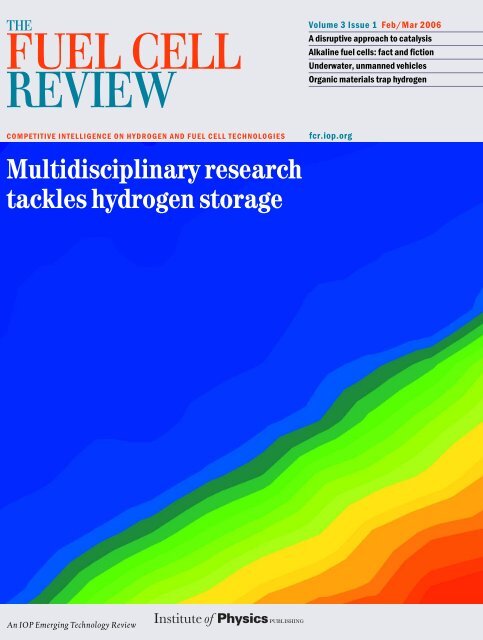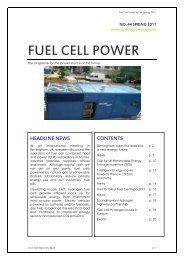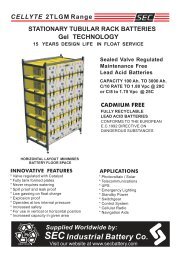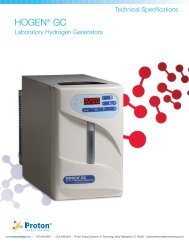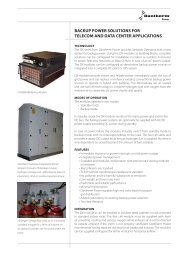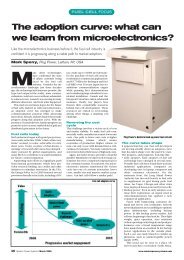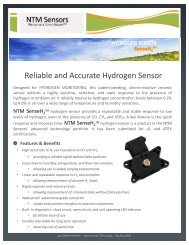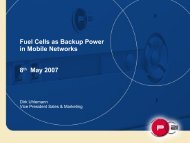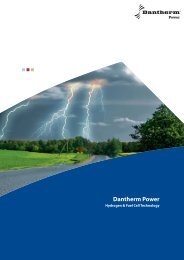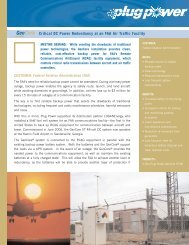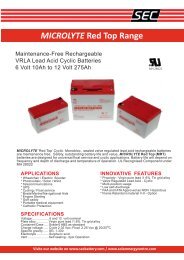A renaissance for alkaline fuel cells - Fuel Cell Markets
A renaissance for alkaline fuel cells - Fuel Cell Markets
A renaissance for alkaline fuel cells - Fuel Cell Markets
Create successful ePaper yourself
Turn your PDF publications into a flip-book with our unique Google optimized e-Paper software.
THE<br />
FUEL CELL<br />
REVIEW<br />
COMPETITIVE INTELLIGENCE ON HYDROGEN AND FUEL CELL TECHNOLOGIES<br />
Multidisciplinary research<br />
tackles hydrogen storage<br />
An IOP Emerging Technology Review<br />
Volume 3 Issue 1 Feb/Mar 2006<br />
A disruptive approach to catalysis<br />
Alkaline <strong>fuel</strong> <strong>cells</strong>: fact and fiction<br />
Underwater, unmanned vehicles<br />
Organic materials trap hydrogen<br />
fcr.iop.org
TL6 Test Load (NEW)<br />
Maximum Power Dissipation 1000 W<br />
TL5 Test Load<br />
Maximum Power Dissipation 100 W<br />
Astris Energi Inc. 2175-6 Dunwin Drive, Mississauga, Ontario, Canada, L5L 1X2<br />
tel: (905) 608-2000 fax: (905) 608-8222 email: questions@astris.ca<br />
SUBSCRIBE TODAY<br />
THE<br />
FUEL CELL<br />
REVIEW<br />
Competitive intelligence on hydrogen<br />
and <strong>fuel</strong>-cell technologies<br />
Why do I need to subscribe?<br />
The <strong>Fuel</strong> <strong>Cell</strong> Review is written and edited <strong>for</strong> executives, engineers and<br />
scientists who appreciate how vital it is to gain regular access to reliable<br />
analysis and reporting on the R&D and emerging applications that will<br />
ultimately trans<strong>for</strong>m hydrogen energy and <strong>fuel</strong>-cell systems into mainstream,<br />
mass-market technologies.<br />
If the magazine is about one thing, it’s about high-value content. That means<br />
industry experts writing on the big issues of the day. It also means<br />
Intelligent Test Loads<br />
Intelligent Test Loads <strong>for</strong> Batteries and <strong>Fuel</strong> <strong>Cell</strong>s are used either stand-alone<br />
or centrally controlled via TESTMASTER Control and Data Acquisition Suite.<br />
Test Load Features:<br />
View real-time data at test location<br />
Multi-range current settings<br />
Resistance free voltage measurement with 0.1, 1, 10 ms delay<br />
Internally limited power dissipation<br />
99:59:59 clock range<br />
Power, Sense, Reference and Temperature ports<br />
Custom expansion ports<br />
✓ Expert commentary from senior figures in the industry<br />
✓ Detailed analysis of the latest emerging technologies and applications<br />
✓ Accessible technology coverage in a commercial context<br />
✓ In-depth interviews with the people who matter<br />
With TESTMASTER:<br />
Control up to 16 TestLoads per string in manual, remote or lockout modes<br />
View data on real-time graphs<br />
Collect, Organize and Analyze data<br />
Automate testing procedures<br />
For in<strong>for</strong>mation and to order this and other Astris products including <strong>Fuel</strong> <strong>Cell</strong><br />
Modules and <strong>Fuel</strong> <strong>Cell</strong> Systems visit www.astris.ca<br />
opinion and analysis from our team of experienced science and technology<br />
editors – all of whom are qualified to postgraduate level in the physical<br />
sciences. To maintain these high editorial standards, The <strong>Fuel</strong> <strong>Cell</strong> Review is<br />
only available on subscription.<br />
Once a subscriber, you will be giving your organization the inside track on the<br />
fundamental scientific, engineering and technology challenges confronting<br />
hydrogen and <strong>fuel</strong>-cell companies across all levels of the supply chain – right<br />
now and in the longer term.<br />
Subscribe online<br />
today at<br />
fcr.iop.org<br />
R EPRINTED WITH PERMISSION. COPYRIGHT I NSTITUTE OF P HYSICS AND IOP PUBLISHING 2006
THIS IS ASTORYof science and technology; of discoveries in<br />
basic research posing a challenge to applied R&D; of 100 years<br />
of daring experiments and false starts finally leading to the first<br />
practical <strong>fuel</strong> cell in the 1930s. This is a story of science and<br />
politics intertwined; companies, large and small, following the<br />
money trail; institutions and industrial enterprises lobbying,<br />
competing <strong>for</strong> and, in the end, depending on public money to<br />
support innovation and advancement. And this is a story of<br />
those investments giving impetus and direction to the roadmap<br />
<strong>for</strong> <strong>fuel</strong>-cell R&D – more often than not, to the detriment<br />
of <strong>alkaline</strong>-<strong>fuel</strong>-cell (AFC) technology.<br />
After their initial spectacular successes in the US and Russian<br />
space programmes in the 1960s and 1970s, AFCs have been<br />
largely sidelined <strong>for</strong> the past 30 years (see “A brief history of<br />
AFC applications”, p20). The view elaborated in this article is<br />
that a <strong>renaissance</strong> of AFC technology is long overdue. The basis<br />
of the argument is clear enough: AFCs exhibit excellent electrochemical<br />
per<strong>for</strong>mance over a range of temperatures and<br />
pressures; they can be built from inexpensive materials – carbon,<br />
plastic and base metals; they employ a cheap electrolyte,<br />
start instantly and work even in deep sub-zero temperatures;<br />
they do not depend on expensive platinum catalysts (and are<br />
there<strong>for</strong>e tolerant of a variety of impurities); and they come<br />
with modest balance-of-plant requirements 1–5 .<br />
Equally, in spite of the fact that AFCs have already notched up<br />
competitive cell and system efficiencies, there is still enormous<br />
room <strong>for</strong> evolutionary engineering improvement. The question<br />
is, will appropriate levels of investment and industrial support<br />
be <strong>for</strong>thcoming?<br />
AFCs in focus<br />
The chemistry of the AFC is summarized in terms of the anode<br />
and cathode reactions. Hydrogen combines with hydroxyl ions<br />
at the anode. Subsequently, the electrons generated in this reaction<br />
travel round an external circuit where they react with oxygen<br />
to <strong>for</strong>m new hydroxyl ions (equation 1).<br />
Fundamentally, AFC design is based on one of four cell/stack<br />
architectures and on the selection of appropriate electrode<br />
materials therein. The path to a cost-effective <strong>fuel</strong> cell is the<br />
common link between these architectures.<br />
FEATURE: INNOVATION<br />
A <strong>renaissance</strong> <strong>for</strong><br />
<strong>alkaline</strong> <strong>fuel</strong> <strong>cells</strong><br />
ERICH GUELZOW, JIRI K NOR, PETER K NOR AND MATHIAS SCHULZE<br />
The <strong>alkaline</strong> <strong>fuel</strong> cell has been the poor relation <strong>for</strong> too long. In what will be seen as a contrarian take by many of<br />
their peers in the development community, the authors argue <strong>for</strong> a re-evaluation of this versatile technology.<br />
R EPRINTED WITH PERMISSION. COPYRIGHT I NSTITUTE OF P HYSICS AND IOP PUBLISHING 2006<br />
They’ve got the power: while AFCs can per<strong>for</strong>m on a par with<br />
competing low-temperature systems, they promise lower capital<br />
and operational costs if developed into a volume technology.<br />
Equation 1: AFC chemistry<br />
Anode: 2H 2 +4OH – → 4H 2O+4e –<br />
Cathode: O 2 +4e – +2H 2O → 4OH –<br />
● Free-electrolyte <strong>cells</strong>: This is the most common cell <strong>for</strong>mat, with<br />
two gas chambers and an electrolyte chamber. Gas-diffusion<br />
electrodes separate reactant gases and the free electrolyte.<br />
● Immobilized-electrolyte <strong>cells</strong>: In space applications, AFCs with<br />
immobilized electrolyte allow position-independent operation<br />
in a low-gravity environment. In principle, the design is the<br />
same as free-electrolyte <strong>cells</strong>, but in this case the electrolyte<br />
space is filled with soaked matrix material (like a sponge).<br />
● ELOFLUX <strong>cells</strong>: The ELOFLUX principle is based on flexible
INNOVATION<br />
A brief history of AFC applications<br />
An ELOFLUX <strong>fuel</strong>-cell cell stack<br />
from German developer<br />
Gaskatel. The ELOFLUX<br />
principle is based on flexible<br />
electrodes and a liquid<br />
electrolyte. The electrodes are<br />
extremely porous, with both<br />
hydrophobic and hydrophilic<br />
pores allowing the transport of<br />
gases and electrolyte, and with<br />
a thin separator between<br />
(approximately 0.3 mm).<br />
It’s within the US space programme that AFCs have enjoyed their<br />
greatest successes. In the 1960s and early 1970s, AFCs were used on<br />
nine Apollo Moon flights and three Sky Labs – a total of 54 missions.<br />
They have also been employed on the Space Shuttle since its first<br />
flight in 1975 and are still in use today.<br />
In terms of more down-to-earth applications, a number of isolated<br />
and diverse projects have relied on the AFC to deliver power from<br />
hydrogen. In the mid-1960s, <strong>for</strong> example, the US tractor maker Allis<br />
Chalmers pioneered the first “civilian” usage: a 15 kW power module<br />
<strong>for</strong> one of its vehicles. Also in the US, Union Carbide developed a<br />
number of initial uses, including a General Motors “Electrovan”<br />
powered by a 125 kW AFC in 1967. Three years later, one of Carbide’s<br />
inventors, Karl Kordesch, completed an Austin A-40 hybrid vehicle<br />
that relied on a 96 V, air-breathing AFC in combination with a leadacid<br />
battery. Kordesch operated the Austin A-40 <strong>for</strong> three years in city<br />
traffic, the <strong>fuel</strong> cell being shut-down and restarted as required by<br />
normal operation.<br />
In terms of European industrial activity, Elenco of Belgium<br />
completed a number of AFC systems during the 1970s and 80s,<br />
including a 52 kW system <strong>for</strong> the Belgian Geological Service. In 1994,<br />
the same group completed work on a 200 kW AFC system <strong>for</strong> a<br />
hybrid bus. The following year Elenco was closed, continuing<br />
operations as Zevco and ZeTek (both now defunct as well). These<br />
companies demonstrated an AFC-powered London taxi in 1999 and<br />
contributed to the completion of the Hydra AFC-powered boat,<br />
which was launched in Germany in the summer of 2000. Elsewhere in<br />
Europe, Siemens of Germany dedicated considerable ef<strong>for</strong>t to<br />
developing a <strong>fuel</strong>-cell system <strong>for</strong> submarines, work that was<br />
completed in the early 1990s.<br />
Back in the here and now there are several small companies and<br />
research institutes currently active in AFC technology. They include:<br />
electrodes and a liquid electrolyte. The electrodes are extremely<br />
porous, with both hydrophobic and hydrophilic pores allowing<br />
the transport of gases and electrolyte, and with a thin separator<br />
between (approximately 0.3 mm). In contrast with the<br />
other cell concepts, the electrolyte is transported through the<br />
separator and the electrodes in the direction perpendicular to<br />
the electrode plane.<br />
This AFC demonstrator from<br />
Hydrocell is equipped with an<br />
internal metal-hydride storage<br />
tank. The Finnish company is<br />
also developing portable AFC<br />
units to supply power to<br />
summer residences and lowenergy<br />
buildings. Because of<br />
the internal hydrogen storage,<br />
the device is sometimes called a<br />
“<strong>fuel</strong>-cell battery”, as it is as<br />
easy to use as a lead acid battery.<br />
● Astris Energi (Mississauga, Ontario) develops systems (ranging in<br />
output power from a few hundred watts to several kilowatts) <strong>for</strong> light<br />
utility vehicles, portable applications and stationary systems<br />
targeting backup power and cogeneration. One such generator, the<br />
Model E8, is a 2.4 kW system that uses two 1.2 kW stacks; system<br />
efficiency is >50% and rated life is 2000 h. Astris has established an<br />
R&D laboratory and manufacturing facility in the Czech Republic.<br />
● Deutsches Zentrum für Luft- und Raumfahrt (DLR) is a leading German<br />
aerospace organization. Its Institute of Technical Thermodynamics in<br />
Stuttgart has a long-running R&D programme on low-temperature<br />
<strong>fuel</strong> <strong>cells</strong>, including PEMFCs and AFCs. There are currently more than<br />
a dozen researchers working on various aspects of AFC technology,<br />
including catalysis, gas-diffusion electrodes, electrode production<br />
methodology, development of stacks, modelling and testing.<br />
● Gaskatel (Kassel, Germany) works on <strong>cells</strong>, stacks and systems based<br />
on the ELOFLUX principle. The ELOFLUX <strong>cells</strong> are based on<br />
inexpensive materials – e.g. carbon and nickel – and deliver a power<br />
output up to 0.5 kW/l.<br />
● Ovonic <strong>Fuel</strong> <strong>Cell</strong> Company (Rochester Hills, Michigan, US) is<br />
developing a metal-hydride <strong>fuel</strong> cell that uses <strong>alkaline</strong> electrolyte.<br />
Published benefits include instant start, intrinsic operation down to<br />
–20 ºC and operation without hydrogen <strong>fuel</strong> <strong>for</strong> several minutes.<br />
● Oy Hydrocell (Finland) manufactures portable AFC systems <strong>for</strong> the<br />
supply of power to summer residences and low-energy buildings.<br />
The <strong>fuel</strong> <strong>cells</strong> are normally equipped with internal metal-hydride<br />
hydrogen storage (up to 40 dm 3 of hydrogen). There are two storage<br />
units: HC-MH200 is the size of a small cola can and contains 430 Wh<br />
(12 V DC, 36 Ah) of energy and the HC-MH1200 is the size of a small<br />
fire extinguisher and contains 2600 Wh (12 V DC, 220 Ah) of energy.<br />
● ZAO Independent Power Technologies (Moscow, Russia) is a designer<br />
and manufacturer of AFC-based electrochemical generators.<br />
● Falling-film cell: This <strong>for</strong>mat was developed by Hoechst,<br />
Germany, originally to increase the efficiency of chlor-alkali<br />
electrolysis. The electrolyte flows between the electrodes from<br />
top to bottom. Owing to the unhindered gravitational movement<br />
of the electrolyte in this way, the typical height-dependent<br />
hydrostatic-pressure distribution does not develop – so<br />
hydrostatic pressure in the free-falling column of liquid is the<br />
R EPRINTED WITH PERMISSION. COPYRIGHT I NSTITUTE OF P HYSICS AND IOP PUBLISHING 2006
1. Electrode aging<br />
potential vs. Hg/HgO (mV) at 100 mA/cm 2<br />
100<br />
50<br />
0<br />
–50<br />
–100<br />
–150<br />
sample 76 (CO 2 contaminated gas)<br />
sample 75<br />
sample 74 (CO 2 contaminated gas)<br />
sample 73<br />
–200<br />
0 1000 2000 3000 4000<br />
time of operation of an Ag–GD electrode at 150 mA/cm 2 (h)<br />
Aging of a silver AFC cathode with either CO 2-containing<br />
oxygen (5%) or pure oxygen. The degradation in per<strong>for</strong>mance in<br />
both modes is comparable, which means that CO 2 neither<br />
enhances the degradation process nor does it induce a new<br />
detrimental effect. Studies on AFC anodes using nitrogen<br />
adsorption measurements, electron microscopy and X-ray<br />
photoelectron spectroscopy also show no deleterious effects.<br />
same at the inlet as at the outlet, and any place in between. The<br />
velocity of the “free fall” is limited only by the turbulent friction<br />
between the falling film and the electrode surface. Highly<br />
porous electrodes are used to separate the electrolyte and the<br />
gas phases, without the need <strong>for</strong> a dedicated separator. <strong>Cell</strong>s in<br />
excess of 1 m 2 have been built using this <strong>for</strong>mat, with bipolar<br />
cell interconnections.<br />
Common to all AFC architectures are the selection of catalyst<br />
material(s) and the electrode production process. For example,<br />
Raney-nickel (anode) and a silver catalyst called SILFON (cathode)<br />
have been used <strong>for</strong> more than 20 years, though there are<br />
plenty of variations on this theme. One method of preparation<br />
of gas-diffusion electrodes is a rolling process in which catalysts<br />
and polytetrafluoroethylene (PTFE) undergo an initial<br />
reactive mixing process, typically using a knife-mill. This<br />
approach yields a bifunctional material system with hydrophilic<br />
and hydrophobic pores. The mixed material is subsequently<br />
rolled onto a metallic mesh that supports the<br />
electrodes, which are then assembled into <strong>cells</strong>.<br />
Debunking the myths<br />
There are all sorts of myths and misconceptions associated<br />
with AFCs. It is said that AFCs are expensive and useful only <strong>for</strong><br />
applications in space; that they require very pure and costly gas<br />
feeds; that they cannot work using air; that they are poisoned<br />
by carbon dioxide; that the liquid electrolyte is a serious drawback;<br />
that carbon monoxide is a problem. So what is true and<br />
what is false? One thing at least is clear: each type of <strong>fuel</strong>-cell<br />
R EPRINTED WITH PERMISSION. COPYRIGHT I NSTITUTE OF P HYSICS AND IOP PUBLISHING 2006<br />
INNOVATION<br />
chemistry has its individual advantages and disadvantages, but<br />
the disadvantages stated here <strong>for</strong> AFCs are grossly exaggerated<br />
or, often, simply incorrect.<br />
Let’s start with cost. AFCs yield savings because their catalysts<br />
need not be based on expensive noble metals – a result of<br />
the lower corrosivity of the basic environment relative to the<br />
acidic one. On top of this, the liquid electrolyte, usually an<br />
aqueous solution of potassium hydroxide, is cheap – just a few<br />
euros per kilogram. Taken together, the catalyst and electrolyte<br />
represent a considerable cost advantage in comparison with<br />
proton exchange membrane <strong>fuel</strong> <strong>cells</strong> (PEMFCs).<br />
However, AFCs are not just about cheaper components. One<br />
of the big pluses in terms of system design is the absence of<br />
process-gas humidification – a significant design headache in<br />
current-generation PEMFCs. Admittedly, some will see the liquid<br />
electrolyte as a disadvantage because AFCs need a circuit<br />
<strong>for</strong> it. In practice, though, a similar circuit is also needed in<br />
PEMFC systems, in this case <strong>for</strong> heat management of the stack.<br />
Effectively, the circulating electrolyte is a “self-healing” layer of<br />
liquid in which any defect (in the <strong>for</strong>m of a bubble, <strong>for</strong> example)<br />
will not remain stationary. Consequently, failure modes (like<br />
hot-spots) common to PEMFCs do not exist. Clearly, the AFC<br />
electrolyte circuit poses some unique design/engineering challenges<br />
owing to its corrosive nature, though the dual purpose of<br />
the circuit (heat and water management) more than offsets those<br />
demands. Additional benefits of this architecture are the elimination<br />
of the water-management issues common to PEMFCs,<br />
which in turn ensures the AFC’s inherent freeze-start capability.<br />
The bogeyman: carbon dioxide<br />
There are some 350 ppm of CO 2 in the air that we breathe.<br />
What’s more, it is commonly accepted that CO 2 intolerance is<br />
the most pronounced disadvantage of air-breathing AFCs. But<br />
is this really the “show-stopper” that some would have us<br />
believe? Karl Kordesch, a pioneering battery and <strong>fuel</strong>-cell<br />
inventor at Union Carbide, US, noted as early as 1970 that the<br />
issue of CO 2 intolerance in AFCs appeared to be overstated. He<br />
found that the rate of absorption of CO 2 in the electrolyte was<br />
negligible at low concentrations and recommended using a<br />
simple dry scrubber with soda lime to counter any take-up. The<br />
same observations were later published by teams at Elenco in<br />
Belgium, Astris Energi in Canada and at the Royal Institute of<br />
Technology in Stockholm, Sweden.<br />
The CO 2 myth persists, however. To investigate the mechanisms<br />
of this CO 2 “poisoning”, a team of scientists at the<br />
Deutsches Zentrum für Luft und Raumfahrt (DLR) in Stuttgart,<br />
Germany, has carried out an in-depth study of the phenomenon<br />
6 . More specifically, AFC gas-diffusion electrodes were<br />
operated in a half-cell configuration <strong>for</strong> up to several thousand<br />
hours with a constant load of 150 mA/cm 2 . The reactants were<br />
contaminated with 5% CO 2 – more than a hundred times<br />
the usual aerial concentration – and the experiments were<br />
per<strong>for</strong>med with both anode and cathode. In parallel, the<br />
researchers carried out a series of control measurements by<br />
operating electrodes with pure reactants.<br />
Using techniques such as scanning electron microscopy and
INNOVATION<br />
2. Electrolyte studies<br />
carbonate concentration (g/l)<br />
40<br />
30<br />
20<br />
10<br />
start of operation with<br />
CO 2 -containing gases<br />
0<br />
0 100 200 300<br />
operation time (h)<br />
400 500 600<br />
In contrast to the electrodes, the AFC electrolyte was affected<br />
by the CO 2-containing gases. During operation with gases<br />
containing 5% CO 2, the carbonate concentration increases<br />
linearly with time. However, according to the DLR team, an<br />
overall charge transfer of 525 A/cm 2 was achieved at CO 2<br />
concentrations some 150 times higher than that in ambient air.<br />
In addition, the electrodes were fully operational at the end of<br />
the experiment.<br />
X-ray photoelectron spectroscopy, the DLR team found that<br />
the per<strong>for</strong>mance of the AFC electrodes decreases over time in<br />
both operation modes, i.e. with or without CO 2 (figure 1).<br />
Furthermore, the decrease in both modes of operation is comparable.<br />
In other words, CO 2 neither enhances the degradation<br />
process nor induces any new, detrimental effect. So while carbonate<br />
concentration in the electrolyte increases during operation<br />
with CO 2-containing gases, there is no evidence that CO 2<br />
affects the electrode degradation process.<br />
Within the electrolyte, CO 2 reacts to <strong>for</strong>m CO 3 2– ions, which<br />
subsequently move to the anodes. Consequently, the DLR team<br />
investigated whether carbonates deposits on the anode were<br />
closing the pores in the electrode. Using nitrogen adsorption<br />
measurements, they found that the specific surface was constant<br />
– i.e. no observed change induced by CO 2. Also, changes<br />
in pore size distribution with lifetime showed no link to CO 2;<br />
the only observation was normal aging of the electrodes.<br />
The DLR team also evaluated the effect of CO 2 on the AFC liquid<br />
electrolyte (figure 2). Gas chromatography measurements<br />
showed that the residual gas behind the anode contains approximately<br />
10% of the CO 2 in the feed gas, while the residual gas of<br />
the cathode contains approximately 20% of the CO 2 in the feed<br />
gas. What this indicates is that most of the CO 2 is dissolved in<br />
the <strong>alkaline</strong> solution by <strong>for</strong>ming potassium carbonate, K 2CO 3.<br />
In long-term experiments with increased K 2CO 3 concentration<br />
up to 450 g/l, the conductivity of the electrolyte is reduced,<br />
while the electrodes remain unaffected.<br />
During operation with 5% CO 2, the carbonate concentration<br />
in the electrolyte increased linearly with operation time. After<br />
3500 h, the experiments were terminated and an overall charge<br />
transfer of 525 Ah/cm 2 was achieved at a CO 2 concentration<br />
3. Efficiency comparisons<br />
voltage (V)<br />
1.00<br />
0.80<br />
0.60<br />
60<br />
0.40<br />
cell voltage, Orbiter<br />
cell voltage, Astris<br />
cell efficiency, Orbiter<br />
40<br />
0.20<br />
cell efficiency, Astris<br />
system efficiency, Astris<br />
20<br />
0.00<br />
0 10 20 30 40 50 60 70 80 90<br />
0<br />
100 110 120<br />
rated power output (%)<br />
<strong>Cell</strong> voltage and efficiency curves <strong>for</strong> two types of AFCs. The top<br />
curves represent a leading-edge noble-metal-catalysed system<br />
(UTC Orbiter), while the lower curves show a terrestrial, airbreathing,<br />
platinum-free system that uses a circulatory<br />
electrolyte <strong>for</strong> heat/water management (Astris). The penalty <strong>for</strong><br />
displacing platinum and operating on ordinary air at<br />
atmospheric pressure is apparent. Efficiencies stated are all<br />
related to the lower heating value of hydrogen.<br />
some 150 times higher than the CO 2 concentration in air.<br />
Significantly, the electrodes were fully operational at the end of<br />
this long-term evaluation. The only conclusion to draw from<br />
this is that CO 2 in the air is not a problem <strong>for</strong> AFCs. Further, if a<br />
change of electrolyte is needed, this is no more complicated or<br />
expensive than changing the oil in an internal combustion<br />
engine. Most importantly, what’s evident is the incorrect nature<br />
of the term “CO 2 poisoning”. Poisoning refers to an effect where<br />
a tiny quantity of a contaminant renders the <strong>fuel</strong>-cell catalyst<br />
largely inoperative. There is no such effect caused by CO 2 in<br />
AFCs, whether they rely on platinum or other catalysts.<br />
By way of a footnote, it’s worth considering CO poisoning, a<br />
serious problem in acidic <strong>fuel</strong> <strong>cells</strong> (PEM and phosphoric acid)<br />
relying on platinum catalysts. In this case, the OH – groups<br />
needed <strong>for</strong> the electrochemical oxidation of CO must be<br />
produced by dissociation of water, under the kinetically<br />
unfavourable conditions of the acid environment. In contrast,<br />
in the <strong>alkaline</strong> milieu, the OH – groups are a part of the electrolyte<br />
and the CO oxidation is not hindered. This appears to<br />
underpin the higher tolerance <strong>for</strong> catalyst poisoning in the case<br />
of platinum-catalysed AFCs, while CO poisoning seems to be<br />
totally absent in AFCs relying on alternative catalysts. (It’s<br />
worth adding, though, that the CO is digested by the AFC as a<br />
<strong>fuel</strong> and oxidized to CO 2; it there<strong>for</strong>e ultimately has the same<br />
effect as CO 2 owing to its absorption in the electrolyte).<br />
Achievements and challenges<br />
Although AFCs have <strong>for</strong> some time been considered of secondary<br />
importance by many in the development community, a<br />
pro-AFC camp of researchers and engineers has been quietly<br />
getting on with the task of enhancing the technology’s funda-<br />
R EPRINTED WITH PERMISSION. COPYRIGHT I NSTITUTE OF P HYSICS AND IOP PUBLISHING 2006<br />
100<br />
80<br />
efficiency (%)
Table 1: AFC catalyst combinations<br />
AFC developer <strong>Fuel</strong> system Operating Anode Cathode<br />
pressure (bar) catalyst catalyst<br />
Bacon* H 2-O 2 45 Ni NiO<br />
UTC-Apollo H 2-O 2 3.4 Ni NiO<br />
UTC-Orbiter H 2-O 2 4 Pt/Pd Au/Pt<br />
Elenco H 2-air atmospheric Pt Pt<br />
Siemens H 2-O 2 2.2 Ni Ag<br />
DLR H 2-air atmospheric Ni Ag<br />
* AFCs developed by F T Bacon at the University of Cambridge, UK, in the 1940s and 50s.<br />
mental per<strong>for</strong>mance metrics. That said, innovation is a moving<br />
target and further improvements and investment are<br />
needed if the AFC is to become a serious contender <strong>for</strong> mainstream<br />
power applications.<br />
● Power density: AFCs are often dismissed as a fringe technology<br />
capable only of low power densities. This unfair declaration<br />
comes from comparing apples and oranges. Put another way,<br />
most current low-temperature <strong>fuel</strong>-cell systems are high-pressure<br />
PEMFCs, whereas the latest AFC systems are atmosphericpressure<br />
systems. Everything being equal, however, AFCs will<br />
match or outper<strong>for</strong>m PEMFCs at high or low pressure. That’s<br />
because the oxygen reaction kinetics, the limiting factor in<br />
hydrogen <strong>fuel</strong> <strong>cells</strong>, are much better in <strong>alkaline</strong> electrolytes<br />
than acidic environments. So while both architectures benefit<br />
from elevated pressure, to reduce the concentration polarization<br />
losses, the effect is less pronounced in <strong>alkaline</strong> media. It’s<br />
because of this attractive low-pressure per<strong>for</strong>mance that the<br />
current generation of terrestrial AFC systems are air-breathing<br />
systems that operate at atmospheric pressure or thereabouts.<br />
Examples of AFC pressurized systems are those that were<br />
deployed on the Apollo or the Space Shuttle Orbiter (SSO)<br />
craft. The latter system (developed in 1979) operated at 90 ºC<br />
and 4 bar; cell voltage was 0.86 V at 470 mA/cm 2 current density<br />
and nominal power of 12 kW. The stack power density was<br />
275 W/kg. In a later application, powerplant <strong>for</strong> the Orbital<br />
Transfer Vehicle (OTV) reached full power of 6.75 kW at 127 ºC<br />
and 10 bar. <strong>Cell</strong> voltage was 0.9 V at current density 1.1 A/cm 2 ,<br />
with remarkable power density of 1.8 kW/kg <strong>for</strong> the stack and<br />
840 W/kg <strong>for</strong> the entire system. Electrodes of the type used in<br />
this application have been capable of supporting current densities<br />
of 5–10 A/cm 2 .<br />
As perhaps the ultimate example of what has been achieved<br />
with AFC technology, UTC of the US (the manufacturer of the<br />
SSO and OTV powerplants) announced in 1987 that it had<br />
developed an advanced AFC system operating at 150 ºC and<br />
13.6 bar, with cell voltage of 0.8 V at 5 A/cm 2 . Stack power density<br />
was 24 kW/kg and the complete system power density<br />
3.3 kW/kg (300 kW, 90 kg). To handle the heat, UTC used active<br />
cooling with water evaporation in the gas flow fields.<br />
Not surprisingly, per<strong>for</strong>mance is dramatically different in<br />
low-pressure AFCs operating at or near atmospheric pressure,<br />
R EPRINTED WITH PERMISSION. COPYRIGHT I NSTITUTE OF P HYSICS AND IOP PUBLISHING 2006<br />
INNOVATION<br />
where the partial pressure of oxygen is only 21% of the atmosphere<br />
(figure 3). Good examples of AFCs in this regime are the<br />
<strong>cells</strong> and systems of Astris. Unlike the space-qualified immobilized-electrolyte<br />
systems, these terrestrial units use a circulating<br />
electrolyte (typically 6–12 M KOH aqueous solution) as a<br />
convenient means of heat and water management. Gas-diffusion<br />
electrodes are capable of supporting current densities up<br />
to 0.5–1 A/cm 2 . However, as an engineering trade-off between<br />
power density and polarization losses, the typical operating<br />
point is in the range 100–200 mA/cm 2 .<br />
● Temperature: AFCs work well at low temperatures. John<br />
Appleby, an electrochemistry specialist at Texas A&M<br />
University, US, points out that aqueous <strong>alkaline</strong>-electrolyte systems<br />
have low activation energy <strong>for</strong> the cell reactions – i.e. they<br />
show a relatively small temperature coefficient of per<strong>for</strong>mance<br />
7 . Consequently, AFCs can often deliver full or near full<br />
power with a “cold start” from room temperature. Even more<br />
significant is their per<strong>for</strong>mance at sub-zero temperatures. As<br />
the electrolyte of the right concentration does not freeze<br />
(26–40% KOH solution will not freeze above –40 ºC), AFCs are<br />
generally capable of starting, alas at reduced power, at these<br />
“deep freeze” temperatures. In contrast, PEMFCs are capable of<br />
operation only above the freezing point of water, while many<br />
PEMs may be damaged by freezing.<br />
● Catalyst: It’s been noted that the inherently faster kinetics of the<br />
oxygen reduction reaction in an AFC opens the way <strong>for</strong> the use<br />
of cheaper, non-noble-metal electrocatalysts 1 . While it is<br />
beyond the scope of this review to tackle this subject in depth, a<br />
look at the latest trends is instructive all the same.<br />
Platinum-group metals still work best in any media, such that<br />
generally there is a per<strong>for</strong>mance penalty associated with<br />
replacement of the noble metals. Innovative electrode engineering<br />
must there<strong>for</strong>e be used to regain the lost ground. For<br />
example, the catalytic activity of nickel as the anode catalyst is<br />
about three orders of magnitude lower than that of platinum.<br />
That per<strong>for</strong>mance deficit can be remedied to some extent with<br />
a much higher electrode loading <strong>for</strong> the cheaper catalyst – by<br />
enlarging the active area using finely divided particles (Raney<br />
Ni) and otherwise optimizing the electrode structure. Apart<br />
from lower cost, another advantage is the low susceptibility of<br />
non-noble catalysts to poisoning.<br />
Table 1 shows the catalysts used by various AFC developers<br />
to date. It is worth noting that in the US (UTC), the evolution<br />
went from essentially the Bacon-type cell (on the Apollo missions)<br />
to a heavily noble-metal-loaded system (Orbiter) – i.e.<br />
best per<strong>for</strong>mance, no consideration of cost. Meanwhile, in<br />
Germany, several groups developed AFCs entirely free of noble<br />
metals (Siemens, Varta, DLR). Variations included the use of<br />
lower-cost noble metals (palladium, ruthenium), base metals<br />
and metal oxides of the spinel and perovskite families, and their<br />
combinations. A notable development in hydrogen anodes is<br />
the use of metal hydrides that provide, in addition to catalytic<br />
properties, a level of hydrogen-storage capacity. Such an<br />
approach is being pursued by the Ovonic <strong>Fuel</strong> <strong>Cell</strong> Company,<br />
US (The <strong>Fuel</strong> <strong>Cell</strong> Review Feb/Mar 2005 p30).<br />
● <strong>Cell</strong> efficiency: Nature has granted AFCs another free gift. The
INNOVATION<br />
faster kinetics of the peroxide reaction on the oxygen electrode<br />
results in lower irreversible losses. In practice it means that in<br />
strong alkali, the oxygen electrode has gained some extra<br />
100 mV. This can be seen in the Pourbaix diagram <strong>for</strong> the oxygen–hydrogen<br />
electrodes 8 .<br />
● System efficiency: While the efficiency of the typical low-temperature,<br />
low-pressure AFCs discussed earlier is by no means<br />
remarkable, the overall system efficiency is. The latest AFC generator<br />
designs from Astris Energi are a case in point. It was possible,<br />
owing to the inherent simplicity of the AFC architecture,<br />
to engineer a system with only three moving parts: an electrolyte<br />
circulation pump, an air pump or blower and a cooling<br />
fan. The entire budget <strong>for</strong> the ancillaries is 5% of the rated<br />
power, which also includes stack parasitic losses and losses due<br />
to venting and purging. This translates to less than 2.5% of the<br />
energy of the incoming <strong>fuel</strong>. There is no compression or<br />
humidification of gases; the pumps must overcome only the<br />
dynamic resistance of the moving fluids. The system efficiency<br />
rises to more than 60% at partial load, and remains above 50%<br />
throughout the operating range from 20 to 120% of full power.<br />
● Operating lifetime and durability: AFCs are rugged per<strong>for</strong>mers<br />
made of plastic, carbon and base metals (i.e. they do not require<br />
fragile graphite components or other exotic materials). Good<br />
operating lifetime is a given. The UTC Orbiter, <strong>for</strong> example, had<br />
a rated life of 2000 h, though in tests it exceeded 10 000 operating<br />
hours and individual stacks were tested beyond 15 000 h.<br />
Meanwhile, terrestrial AFCs have a rated life of 2000 h (Astris),<br />
with individual <strong>cells</strong> and electrodes tested to 5000–8000 h.<br />
● Failure modes and safety: AFCs tend not to fail catastrophically,<br />
but rather decline gradually in per<strong>for</strong>mance terms. Most manufacturers<br />
declare the end-of-life when per<strong>for</strong>mance falls below<br />
a predetermined level, usually caused by the corrosion and<br />
agglomeration of a catalyst and loss of repellence of the gas-diffusion<br />
electrodes. However, as long as the electrodes are in the<br />
wet state, <strong>fuel</strong> and oxidizer never meet and there is no danger<br />
of internal stack failure. Even if the electrolyte is removed<br />
be<strong>for</strong>e the reactants, wet electrodes will remain impervious to<br />
gases <strong>for</strong> many hours. This inherent safety should be considered<br />
an advantage over solid-electrolyte <strong>cells</strong> – PEMFCs and<br />
solid-oxide <strong>fuel</strong> <strong>cells</strong> (SOFCs) – where cracks, pinholes or<br />
hotspots in the electrolyte may lead to dangerous flash<br />
through, internal fire and stack destruction.<br />
● System design, balance-of-plant and materials of construction: One<br />
look inside an AFC generator built with the philosophy of<br />
“good per<strong>for</strong>mance at low cost” reveals inexpensive plastic<br />
parts, fittings, pipes and tubes. What’s more, the inherent simplicity<br />
of the balance-of-plant is striking. The <strong>fuel</strong>-delivery circuit<br />
uses a low-pressure regulator that feeds hydrogen to the<br />
stacks and a simple provision <strong>for</strong> purging of impurities from<br />
the stack. <strong>Fuel</strong> may be recirculated but often is “dead-ended” in<br />
the stack. A pump or a blower provides an air supply to the<br />
stacks in excess of the stoichiometric value. The electrolyte circuit<br />
with a pump, heat exchanger(s), filter and a cooling fan is<br />
usually the most complicated subsystem.<br />
● Capital cost: Five years ago, the cost of source materials <strong>for</strong> an<br />
AFC stack was just over €1100/kW. More recently, per<strong>for</strong>m-<br />
ance has been enhanced and the cost of materials brought<br />
down to €430–460/kW 9 . Meanwhile, Astris Energi reported a<br />
source material cost of $275/kW in 2004. With further evolution<br />
in per<strong>for</strong>mance, increased production volumes, reduced<br />
labour content and enhanced yields, it is conceivable that the<br />
cost of stacks will drop below the $400/kW level in annual<br />
quantities of 10 000 kW. If appropriate investment is <strong>for</strong>thcoming,<br />
the authors believe that, given sufficient volumes, with<br />
AFC stacks in the few hundred dollars range, the complete system<br />
selling price can break through the magic barrier of<br />
$1000/kW, with a healthy margin over the manufacturing cost.<br />
● Operating cost: While AFC technology has the potential to<br />
become the cheapest low-temperature <strong>fuel</strong> cell – and apart<br />
from high-temperature SOFCs, probably the cheapest <strong>fuel</strong> cell<br />
on the market – it also comes with a very low operational cost.<br />
Versatile per<strong>for</strong>mance is achieved with the least expensive<br />
industrial-grade hydrogen (99.9%) and even with unpurified,<br />
raw electrolytic hydrogen. In the platinum-free embodiment<br />
with circulating electrolyte, AFCs are insensitive to trace carbon<br />
oxides, and inert to most other impurities. Cost of the consumables<br />
(soda lime and, in some cases, potassium hydroxide)<br />
may add some 0.2–2 cents/kWh 1 .<br />
Commercial opportunities<br />
Right now, <strong>fuel</strong> <strong>cells</strong> of all types are being corralled into applications<br />
where they can potentially displace incumbent powergeneration<br />
schemes. As a result, the approach to market entry is<br />
largely based on the cost dynamic that the <strong>fuel</strong> cell can achieve<br />
compared with the existing technology of choice. In most<br />
cases, comparing only the capital or purchase cost is not currently<br />
sufficient to prove the business case positive <strong>for</strong> <strong>fuel</strong> <strong>cells</strong>.<br />
In many cases, the benefits of <strong>fuel</strong>-cell operation must be<br />
proved based on a total cost of ownership owing to higher reliability<br />
and elimination of peripheral equipment (e.g. because<br />
of quiet or emission-free operation). The value proposition<br />
delivered by AFCs is similar to other low-temperature <strong>fuel</strong> <strong>cells</strong>,<br />
namely PEMFCs, with the added advantage that both capital<br />
cost and operations cost are considerably lower. Initial applications<br />
are expected to be as backup power sources and in light<br />
mobility, though declining AFC price points could in time open<br />
up additional markets.<br />
● Backup power: The list of applications that must be either shutdown<br />
in a controlled manner or operated <strong>for</strong> long periods without<br />
their normal power supply is a long one and includes<br />
mechanical systems (such as elevators) and all manner of hardware<br />
in telecommunications and computing networks. Today,<br />
the majority of backup schemes rely heavily on banks of leadacid<br />
batteries, sometimes supplemented by a diesel or gasoline<br />
generator. <strong>Fuel</strong> <strong>cells</strong> that can be produced economically will be<br />
able to deliver increased per<strong>for</strong>mance and offer a savings to the<br />
operator <strong>for</strong> a variety of backup power applications owing to<br />
decreased maintenance, simpler installation and enhanced<br />
reliability. There is an incredible advantage to having a power<br />
supply that is fully independent from the primary supply. In<br />
times of extended power outage, <strong>for</strong> example, additional gas<br />
cylinders can be delivered to power the backup power system,<br />
R EPRINTED WITH PERMISSION. COPYRIGHT I NSTITUTE OF P HYSICS AND IOP PUBLISHING 2006
Making the breakthrough: if<br />
they can be turned into<br />
commercial products, AFCs are<br />
likely to find initial applications<br />
as backup power sources <strong>for</strong><br />
wireless base stations and as<br />
primary sources in a variety of<br />
light utility vehicles (e.g. the<br />
golf car shown above).<br />
an option that does not exist <strong>for</strong> batteries.<br />
Although purchase cost is a big factor governing the take-up<br />
of any new technology, there are many secondary benefits<br />
associated with an AFC-based backup system. Of particular<br />
importance are those that can be translated into savings in<br />
infrastructure or operations/maintenance. In the case of a<br />
backup unit that delivers 2 kW <strong>for</strong> 10 h, the existing battery<br />
solution would weigh in excess of 2000 lb, whereas the <strong>fuel</strong>-cell<br />
option would weigh less than 300 lb and would occupy only a<br />
fraction of the space.<br />
● Light utility vehicles: Increasing numbers of electric vehicles are<br />
in use today – as “people movers” at airports, large industrial<br />
plants and golf courses, as well as <strong>for</strong> materials handling in<br />
warehouses. These vehicles are typically powered by an onboard<br />
battery that has a number of limitations. Most impor-<br />
R EPRINTED WITH PERMISSION. COPYRIGHT I NSTITUTE OF P HYSICS AND IOP PUBLISHING 2006<br />
INNOVATION<br />
tantly, batteries typically take hours to recharge, which means<br />
that continuous operations <strong>for</strong>ce the user to have multiple vehicles<br />
(or at a minimum, multiple batteries) on hand. The cost of<br />
battery handling, charging and spare batteries (or even spare<br />
vehicles in some cases) is considerable.<br />
The <strong>fuel</strong>-cell-powered vehicle can run <strong>for</strong> a complete shift<br />
and typically be re<strong>fuel</strong>led in less than a minute, thereby eliminating<br />
the need <strong>for</strong> spare vehicles/batteries. Furthermore, the<br />
<strong>fuel</strong>-cell vehicle offers improved per<strong>for</strong>mance, owing to<br />
reduced overall weight and elimination of “battery-fade”. The<br />
golf car shown above is 20% lighter than the battery-powered<br />
version and runs <strong>for</strong> three days between re<strong>fuel</strong>ling (based on<br />
typical usage). It is also emissions-free and virtually silent, so<br />
can work indoors or outdoors.<br />
Which way now?<br />
In summary, AFCs have the potential to become a key technology<br />
in the low-temperature regime, one that <strong>for</strong>ms the basis of<br />
power-generation schemes that work as well as or better than<br />
competing approaches, and do so at lower capital and operational<br />
cost. Much of the technology’s potential still lies unexplored<br />
and under-utilized, chiefly because the bulk of the<br />
investment dollars have hitherto been directed towards the<br />
R&D and commercialization of PEMFCs.<br />
For the AFC community, this should be seen as positive not<br />
negative, in that there is plenty of scope <strong>for</strong> incremental and dislocating<br />
innovation with only modest levels of investment. The<br />
commercial opportunity is there. Who will embrace that<br />
opportunity and take advantage of it? ●<br />
Further reading<br />
1. G F McLean et al. 2002 An assessment of <strong>alkaline</strong> <strong>fuel</strong> cell technology.<br />
Int. J. of Hyd. Ener. 27 507–26.<br />
2. E Guelzow 1996 Alkaline <strong>fuel</strong> <strong>cells</strong>: a critical view. J. Power Sources 61<br />
99–104.<br />
3. T Burchardt et al. 2002 Alkaline <strong>fuel</strong> <strong>cells</strong>: contemporary advancement<br />
and limitations <strong>Fuel</strong> 81 2151–55.<br />
4. M Cifrain and K Kordesch 2003 Hydrogen/oxygen (air) <strong>fuel</strong> <strong>cells</strong> with<br />
<strong>alkaline</strong> electrolytes in Handbook of <strong>Fuel</strong> <strong>Cell</strong>s Vol. 1 4 267–80 (Wiley,<br />
Chichester).<br />
5. K Kordesch and G Simader 1996 <strong>Fuel</strong> <strong>Cell</strong>s and their Applications<br />
(Wiley, New York).<br />
6. E Guelzow and M Schulze 2004 Long-term operation of AFC<br />
electrodes with CO 2 containing gases. J. Power Sources 127 243–51.<br />
7. A J Appleby and F R Foulkes 1989 <strong>Fuel</strong> <strong>Cell</strong> Handbook (Van Nostrand<br />
Reinhold, New York) p262.<br />
8. M Pourbaix 1966 Atlas of Electrochemical Equilibria (Pergamon Press,<br />
New York).<br />
9. P Gouerec et al. 2004 The evolution of the per<strong>for</strong>mance of <strong>alkaline</strong> <strong>fuel</strong><br />
<strong>cells</strong> with circulating electrolyte J. Power Sources 129 193–204.<br />
Erich Guelzow is head of the low-temperature <strong>fuel</strong>-cell group at Deutsches<br />
Zentrum für Luft und Raumfahrt (DLR) in Stuttgart, Germany. Jiri K Nor is<br />
president and chief technology officer of Astris Energi in Toronto, Canada. Peter<br />
K Nor is vice-president, business development and marketing at Astris Energi.<br />
Mathias Schulze is a <strong>fuel</strong>-cell scientist responsible <strong>for</strong> characterization of <strong>fuel</strong>cell<br />
components and investigation of their degradation mechanisms at DLR.


